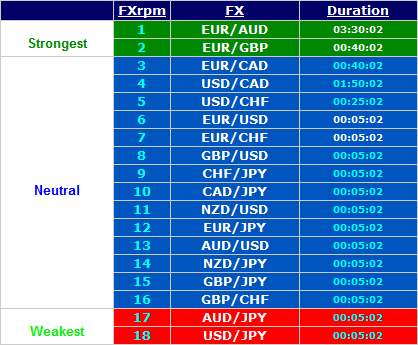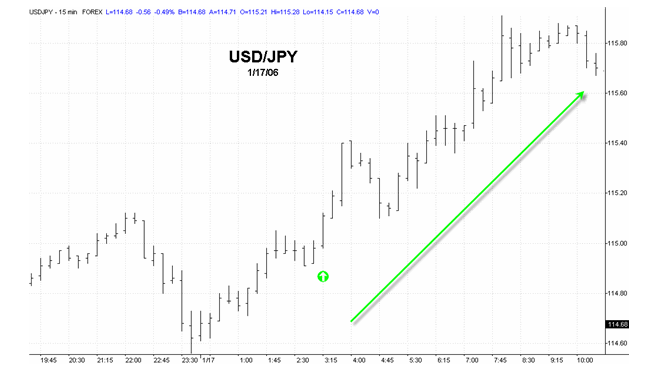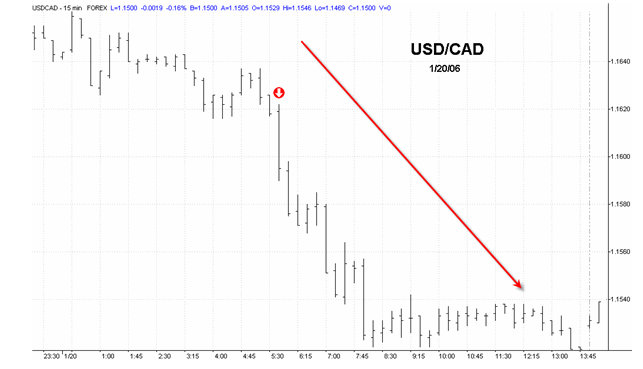How to Use FXrpm
Trading successfully requires a
simple yet effective system to enter and exit trades. I’d like to show you our
proprietary forex ranking method called
FXrpm. This is a simple-to-use indicator that looks at the seven most popular
cross-currencies and identifies the strongest and weakest pairs.
FXrpm is based upon a proprietary algorithm created by Cesar Alvarez, Director
of Research for Connors Research. This specialized method is
able to identify which currency pairs are seeing large inflows of money and
which pairs are seeing large outflows. A rating is then given to each
pair between 1-18, with 1 being the strongest and 18 being the weakest.
First we need to check the
FXrpm
page. As you can see, the strongest two pairs are in
green and the weakest two pairs are in
red. The pairs in the middle are neutral. You should be looking for long entries (buy setups) in the
two strongest pairs (green).
Conversely you should be looking for short entries (sell setups) in the two
weakest pairs (red).

Here are 4 basic strategies to consider while using FXrpm:
1. 1‘s and
2‘s are possible
candidates for long positions. 17‘s
and 18‘s are
possible candidates for short positions. You could potentially look at going
long the currencies with an FXrpm level at
1 and/or 2,
and potentially look at shorting the currencies with an FXrpm level at
17 and/or
18. The exit could
be when the currency drops out of the green zones when you are long, or moves
out of the red zone when you are short (please make sure you understand the
possible weighting of the US Dollar on your positions. Your brokerage firm can
guide you with this).
2. Look for upward and downward changes in the FXrpm level. A currency
which has moved from weakest to strongest is telling you that money is flowing
into this currency. You may want to track these currencies as the money flow
could potentially continue. The same holds true for currencies dropping in
ranking. A currency dropping from a stronger FXrpm level to a weaker FXrpm level
is telling you that money flow is moving out of that currency.![]()
3. Look at 1‘s
& 2‘s on pullbacks,
and look at 17‘s &
18‘s on upward
pullbacks. One of the more popular ways to trade currencies is on pullbacks.
Wait for a strong currency to pull back to some specific level and then look to
enter. These entry levels can be pullbacks to moving averages, Fibonacci levels,
or other popular pullback strategies.![]()
4. Wait for reversal set-ups on the extremes, especially markets which
have been strong or weak for a long period of time. If a currency is rated a
1 or a
18 for a sustained
period of time, it could be reaching overbought or oversold levels. Many large
reversals precede these conditions. Ideally, you’ll want to short a currency
which has been rated 1
for many hours and then begins selling off or dropping in ranking. The same
holds true for currencies rated 18.
If it’s been selling off for many hours/days and then reverses, or its FXrpm
level rises, it may be signaling a reversal is beginning.
Let’s take a look at some actual trading examples:
On 1/17/06 USD/JPY had an FXrpm reading of 1 at 3:15 AM (small green arrow). As you
can see, this led to a very large rally.

On 1/20/06 USD/CAD
had an FXrpm reading
of 7 at 5:45 AM (small red arrow). In this
example, USD/CAD declined sharply for the next 2-hours.

Obviously every trade won’t work out
this well. However, as these two examples show, FXrpm
can help improve your trading. They should not be used exclusively as buy/sell
signals, but in conjunction with chart patterns, economic/fundamental news, etc.
Click here for more information on
FXrpm. To help you get started we have strategies you could employ in
addition to running free training classes every day that are designed to help
you understand FXrpm
and how to use them more effectively.
